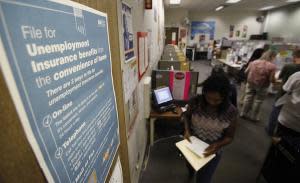 The Lookout
The LookoutStates turn down federal money for jobless benefits

Despite record levels of long-term unemployment, some states are choosing to walk away from a total of almost $1 billion in federal jobless benefits, according to a new report (pdf).
The 2009 American Reinvestment and Recovery Act, better known as the stimulus law, extends unemployment benefits to the fast-growing number of Americans who have been without work for six months or more. In addition to helping the jobless, the federal funds offer a much-needed economic stimulus for states.
To qualify for the program, known as Extended Benefits, states must meet certain unemployment thresholds. Most must also pass new legislation empowering them to access the money—and 26 states have done so to date. But according to the National Employment Law Project (NELP) nine eligible states—Arkansas, Iowa, Louisiana, Maryland, Mississippi, Montana, Oklahoma, Utah and Wyoming—have so far left a total of around $876 million in federal jobless benefits on the table, even though the costs of claiming the benefits under the program are reportedly minimal.
It's not as if the states couldn't use the extra cash right now. Thanks to budget shortfalls of varying degrees of severity, all have cut spending in other areas. But for now, they're saying thanks but no thanks to an average of almost $100 million per state in federal money.
Efforts are under way in three of those states—Iowa, Maryland, Montana—to pass the necessary legislation, according to NELP, though they're by no means guaranteed to succeed. And Renny MacKay, a spokeswoman for Governor Matt Mead of Wyoming told The Lookout that lawmakers there are weighing a similar measure. Spokespeople for the governors of Louisiana, Mississippi and Oklahoma did not respond to requests for comment.
Many of the states have said that they're reluctant to pass the necessary legislation, because the program essentially doesn't cover extended benefits for state and local government workers. The effect of that omission, state political leaders say, is to force their already cash-strapped governments to cover those costs.
Both Utah and Arkansas said as much to The Lookout.
Ally Isom, a spokeswoman for Utah governor Gary Herbert, a Republican, said the legislature in her state isn't interested in the program, because of the expected effect on state and local budgets. "We're a fiscally conservative state, and the budget is extremely challenging right now," Isom told The Lookout. "There's not an appetite to tap state coffers for extended unemployment benefits at this time."
"We did not feel it was appropriate to … trigger the program in Arkansas," Kimberly Friedman, a spokeswoman for the Arkansas Department of Workforce Services, told The Lookout via email, citing the same concerns. "We feel that our current program is effective."
But the study describes the cost to the states as "minimal," noting that the nine states still abstaining from the program collectively have directed an average of just 2.7 percent of all regular state benefits to out-of-work government employees. The costs of such outlays are far outweighed by the stimulative effect that the program at large would create for hard-up state economies, NELP argues. Economists at the liberal Economic Policy Institute and the Center for Budget and Policy Priorities say their research bears that out.
And if there's even a short-term stimulative gain from such benefits, it would likely help take some of the pain out of the current jobs crisis, which is fast becoming a crisis of long-term unemployment. While layoffs are rare these days, the average length of unemployment currently stands at an all-time record of nine months, according to the January jobs numbers released Friday by the Labor Department. And the longer a person is unemployed, the harder it is to find a job. Taking advantage of the federal money would give an estimated 236,000 jobless Americans an extra 13-20 weeks of benefits, NELP's report found.
In addition, the money from Washington would provide a nearly $1 billion state-level stimulus—again, that's almost $100 million on average per state. And research shows that unemployment benefits are among the most efficient ways to stimulate the economy, because the unemployed have little choice but to spend the extra money—thereby stimulating sluggish consumer demand.
Some economists argue that the stimulative effects alone make accessing the federal money a no-brainer. "States that don't do it are weakening their economy if they're leaving people without any income," Iris Lav of the Center on Budget and Policy Priorities told The Lookout. "It's a good deal for the states."
Christine Riordan of NELP likewise told The Lookout that the nine states still abstaining from the program "don't really have an excuse not to get this done." But it's still far from clear whether the states that have resisted taking federal benefits this far into the jobs crisis intend to start doing so now.
(Job seekers at an employment office in Menlo Park, Calif.: Paul Sakuma/AP)
